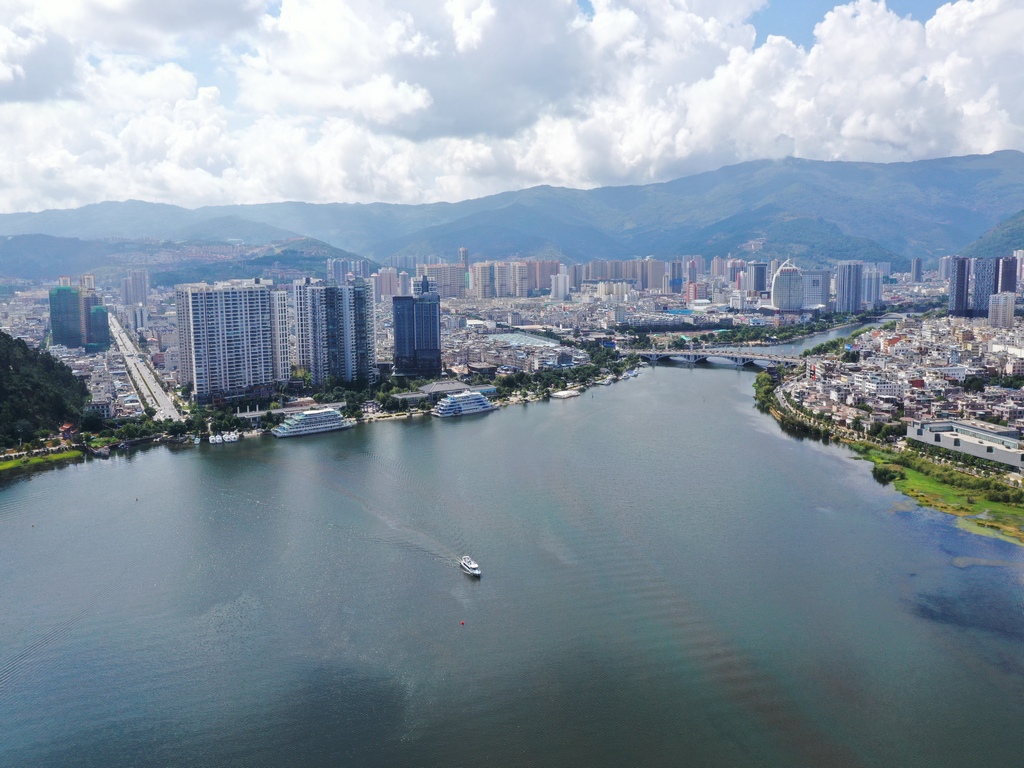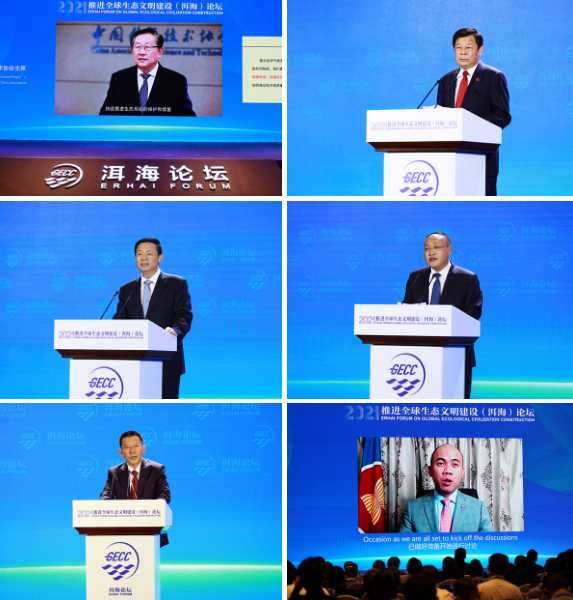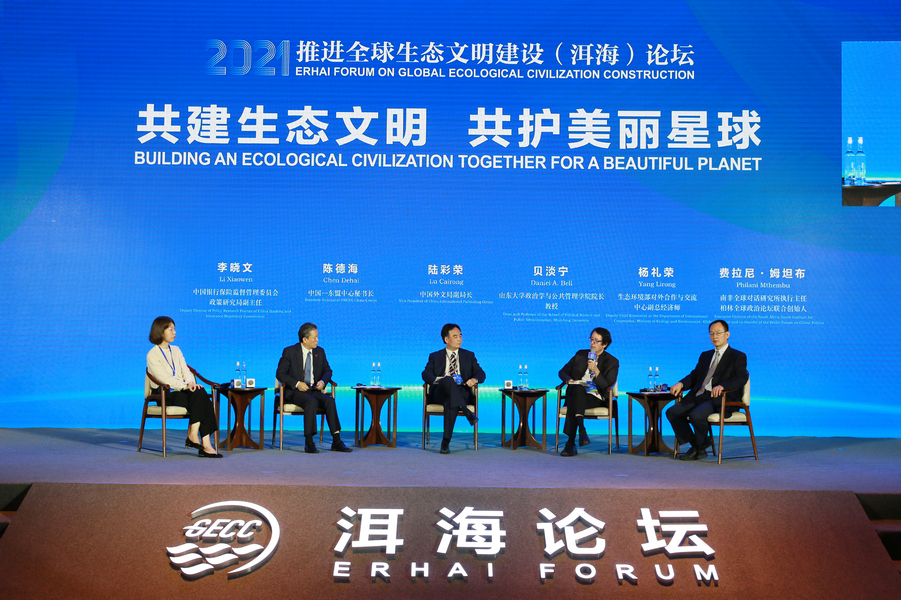Erhai Forum: Scenes of China’s Ecological Civilization

In the golden autumn of October, the Erhai Lake Ecological Corridor, a monitoring system for the lake, is composed of continuous green belts across Dali City in southwestern China’s Yunnan Province. Ottelia acuminata dotting clear Erhai Lake looks like stars scattered across the sky. Because it needs high-quality water to grow, the delicate flower is known as a “bellwether of water quality” and used to gauge water quality in the area. In past decades, the plant disappeared from Erhai completely due to water pollution. Luckily, the white flower has been thriving again thanks to the implementation of environmental protection measures in recent years, restoring the glamour of the mother lake for Dali locals.
An international forum on ecological civilization kicked off in poetic and picturesque Dali City at the foot of Cangshan Mountain and beside Erhai Lake on October 9, 2021. A sideline event of the 15th meeting of the Conference of the Parties to the Convention on Biological Diversity (COP15) in Kunming, the forum brought together more than 300 participants including government leaders, entrepreneurs, and environmental champions from across the globe to share ideas on building an eco-friendly world.
Old Man and the Lake
During an inspection tour of Yunnan in January 2015, Chinese President Xi Jinping visited Erhai Lake and called on residents and the local government to protect the lake’s natural beauty forever, launching a major local fight against lake pollution.
Ultimate victory in the fight against lake pollution could have never been achieved without the dedication and hard work of 71-year-old Kong Hainan, a professor at the School of Environmental Science and Engineering, Shanghai Jiao Tong University. Kong considers his life experience simple and his work is all about Erhai’s ecological restoration. His first contact with the lake happened back in 1987 when he was working with Japan’s National Institute for Environmental Studies to perform comparative research on Erhai Lake and various Japanese lakes. In 2003, three years after returning to China, he brought the septic tank technology to Dali as head of the pollution control and treatment program of Erhai Lake. A total of 250 tons of domestic wastewater can be treated daily to meet discharge standards. Now, 30 sets of treatment systems have been installed in a dozen towns around Erhai, laying a solid foundation for the ecological restoration of the lake.
Over the past two decades, Kong and his colleagues have remained devoted to the ecological conservation of Erhai Lake. Many species that once disappeared now thrive again in the lake like Ottelia acuminate and Dali carp. And new bird species that had never appeared before have been finding new habitats there.
Kong has deep affection for Ottelia acuminate. “The aquatic flower testifies to how local people have saved and protected Erhai Lake,” he said. “The aquatic plant, which can be eaten as a tasty dish, has become a source of income for local farmers.” Kong believes that the lessons learned in the ecological restoration of Erhai Lake can offer a reference for lake protection and management in other developing countries. The forum offered a platform to spread the Erhai model and experience around the world.
Now, the ecological corridor along Erhai Lake attracts tourists from all over the world. The 129-kilometer corridor safeguards the environment of Erhai Lake while providing ecological dividends to locals who protect it.
Over the past five years, Dali has invested a total of 33 billion yuan (US$5.2 billion) in the protection and treatment of Erhai Lake, ensuring its good water quality. Green is the new gold. The output value of ecological agriculture in Dali Bai Autonomous Prefecture has exceeded 60 billion yuan (US$9.4 billion), according to Yang Guozong, Party chief of the prefecture.

October 9, 2021: Guests deliver speeches at an international forum on ecological civilization, called the “Erhai Forum” for short, in Dali City, southwestern China’s Yunnan Province. The forum gathered more than 300 participants from around the world to discuss challenges and solutions for global ecological conservation. courtesy of China Report
Engaging Ecological Stories
In addition to the Erhai case, Yunnan has also set a prime example of how to engage more people in ecological protection. Earlier this year, a herd of wild Asian elephants that left Xishuangbanna National Nature Reserve in southern Yunnan traveled nearly 500 kilometers northwards, grabbing media spotlight in China and beyond.
“Yunnan media outlets are enthusiastic about interacting with global netizens interested in helping care for elephants, and we naturally share stories about what the province has done to protect the habitat of Asian elephants and ensure harmonious coexistence between humans and elephants,” said He Zukun, president of Yunnan Daily.
The local media has explored various angles of the elephants’ journey. They produced short videos, designed emoticons, and created other popular new media products depicting the cute animals. The wild Asian elephants became the “top ambassador” of Yunnan. International environmental champions and animal protectors were invited to discuss the protection of Asian elephants. Often humorous and down-to-earth methods of storytelling were well-received and praised by the media and netizens around the world across political, cultural, and geographical boundaries.
A lovely and beautiful profile of China unfolded alongside the epic journey of the elephants. The website of French magazine Paris Match posted pictures of the elephants lying down and resting, and hailed it as a beautiful Chinese scene. Such a scene was particularly heartwarming and inspiring in the complicated international landscape amidst the COVID-19 pandemic.
While these Asian elephants were trekking across Yunnan, more than 2,000 kilometers away in Beijing, Jia Feng, director of the Center for Environmental Education and Communications under the Ministry of Ecology and Environment, was embarking on a journey of research on green travel.
Studies show that global per capita carbon emissions were about four tons in 2020, of which 40 to 70 percent emitted through consumption. Housing, travel, and food accounted for as much as 75 percent of each consumer’s carbon footprint. Jia has suggested people live a simple, moderate, healthy, and responsible lifestyle based on green, low-carbon, and sustainable consumption.
A year and a half ago, Jia and his team launched a research project. They started riding bicycles to and from work, routinely posting their cycling travels on China’s twitter-like Weibo, and collecting feedback from netizens to explore ways to promote cycling in the name of cleaner urban environments. News reports of their cycling experiment have been read more than eight million times on Weibo. Jia believes that good stories are built on meaningful endeavors. Green and low-carbon travel is what people care about, so the experiment effectively reached out to more people and urged them to support environmental protection.
By cycling more than 350 days in 18 months, Jia personally reduced about a ton of carbon emissions. He walks the walk as an environmental education expert by living a vividly green, low-carbon life. “‘Do as I do’ is far more effective than ‘do as I say’ in terms of improving environmental awareness and guiding the public towards greener living,” he said.

October 9, 2021: Officials, experts and entrepreneurs have a panel discussion under the theme of “Building an Ecological Civilization Together for a Beautiful Planet” at the Erhai Forum. courtesy of China Report